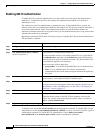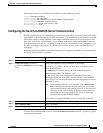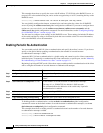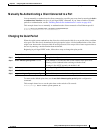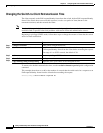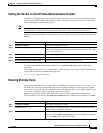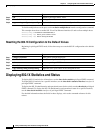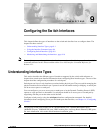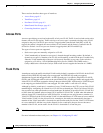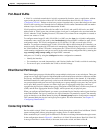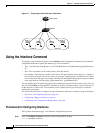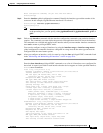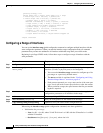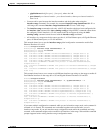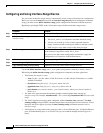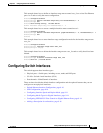
9-2
Catalyst 2950 Desktop Switch Software Configuration Guide
78-14982-01
Chapter 9 Configuring the Switch Interfaces
Understanding Interface Types
These sections describes these types of interfaces:
• Access Ports, page 9-2
• Trunk Ports, page 9-2
• Port-Based VLANs, page 9-3
• EtherChannel Port Groups, page 9-3
• Connecting Interfaces, page 9-3
Access Ports
An access port belongs to and carries the traffic of only one VLAN. Traffic is received and sent in native
formats with no VLAN tagging. Traffic arriving on an access port is assumed to belong to the VLAN
assigned to the port. If an access port receives a tagged packet (Inter-Switch Link [ISL] or 802.1Q
tagged), the packet is dropped, the source address is not learned, and the frame is counted in the No
destination statistic. An access port can forward a tagged packet (802.1P and 802.1Q).
Two types of access ports are supported:
• Static access ports are manually assigned to a VLAN.
• VLAN membership of dynamic access ports is learned through incoming packets. By default, a
dynamic access port is a member of no VLAN, and forwarding to and from the port is enabled only
when the VLAN membership of the port is discovered. Dynamic access ports on the switch are
assigned to a VLAN by a VLAN Membership Policy Server (VMPS). The VMPS can be a
Catalyst 6000 series switch; the Catalyst 2950 switch does not support the function of a VMPS.
Trunk Ports
A trunk port carries the traffic of multiple VLANs and by default is a member of all VLANs in the VLAN
database. Only IEEE 802.1Q trunk ports are supported. An IEEE 802.1Q trunk port supports
simultaneous tagged and untagged traffic. An 802.1Q trunk port is assigned a default Port VLAN ID
(PVID), and all untagged traffic travels on the port default PVID. All untagged traffic and tagged traffic
with a NULL VLAN ID are assumed to belong to the port default PVID. A packet with a VLAN ID equal
to the outgoing port default PVID is sent untagged. All other traffic is sent with a VLAN tag.
Although by default, a trunk port is a member of every VLAN known to the VTP, you can limit VLAN
membership by configuring an allowed list of VLANs for each trunk port. The list of allowed VLANs
does not affect any other port but the associated trunk port. By default, all possible VLANs (VLAN ID 1
to 1005 when the standard software image [SI] is installed or VLAN ID 1 to 4094 when the enhanced
software image [EI] is installed) are in the allowed list. A trunk port can only become a member of a
VLAN if VTP knows of the VLAN and the VLAN is in the enabled state. If VTP learns of a new, enabled
VLAN and the VLAN is in the allowed list for a trunk port, the trunk port automatically becomes a
member of that VLAN and traffic is forwarded to and from the trunk port for that VLAN. If VTP learns
of a new, enabled VLAN that is not in the allowed list for a trunk port, the port does not become a
member of the VLAN, and no traffic for the VLAN is forwarded to or from the port.
Note VLAN 1 cannot be excluded from the allowed list.
For more information about trunk ports, see Chapter 14, “Configuring VLANs.”



